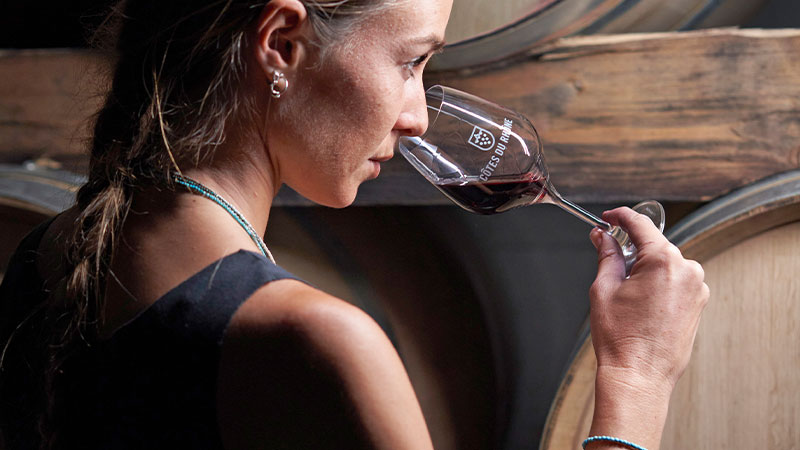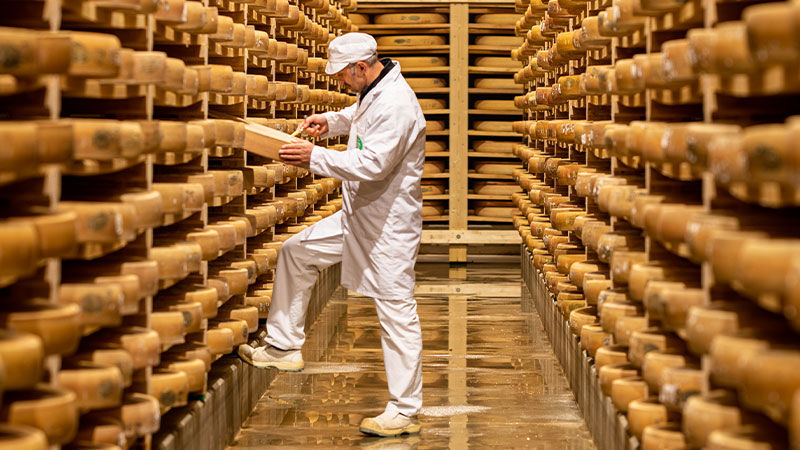
Composing the perfect cheese and wine pairing is all about harmony and balance. These lofty ideals might feel intimidating, but you probably know more about them than you realize. Even if you can’t rattle off every grape variety in the Côtes du Rhône or you’re not sure exactly what gives older cheeses their slight crunch (answer: amino acid crystallization), you know whether a pairing works for you as soon as you taste it. Allowing yourself to experiment, and trusting yourself and your palate, makes finding the perfect pairing rather simple.
Actually, trust might be the secret ingredient in more than one way. Which cheeses and wines are better to trust in the pairing game than those that have proven themselves countless times over the past few hundred years, those that have played an integral role in our communal gatherings, having been served at dinner parties, holiday gatherings, weddings, and more?
Enter Côtes du Rhône wine and Comté cheese, a match made in culinary heaven.
Parallel Histories

Both Comté and Côtes du Rhône have been emblematic of their respective regions for centuries. The production of Comté in France’s mountainous Jura region dates back to the Neolithic period, and Latin texts reference that Jura cheese was enjoyed in ancient Rome. Thirteenth-century texts document the “fruitières” system in the region, Comté’s cooperative system in which farmers pool their milk and cheese production in shared facilities, ensuring that large nutrient-dense cheese was available all winter long for these communities. Today, there are 14,000 jobs created by Comté production, including farmers, cheesemakers, and affineurs who are responsible for guiding cheese through the aging process.
Wine production in the Côtes du Rhône dates back at least 2,000 years when Greeks and Romans settled the area. The area’s viticultural reputation spread, and by the early 17th century, regulations had been set that protected the region from being counterfeited and its unique expression of terroir. Today, there are 53,000 jobs associated with Côtes du Rhône production.
The past, present, and future of these historic regions are uniquely tied to the cheese and wine produced there. As such, both products have strict stipulations around their production, codified through Protected Designation of Origin (PDO) regulations. The PDO protects both consumers and producers, ensuring that products made under its purview are representative of the quality that the region is famed for.
A Shared Love of Terroir Results in Shared Values
The concept of “terroir” is multi-faceted, but at a basic level, it celebrates that a product could not have come from any other place, thanks to both the unique geographical features of an area, as well as its traditions and craftspeople. Both the Comté and Côtes du Rhône PDOs are committed to protecting their unique terroirs in myriad ways, including preserving each region’s biodiversity and natural resources, ensuring that the humans and animals involved in the processes are well cared for, and setting clear and transparent standards that ensure quality at every step of the process.
Comté and Côtes du Rhône are connected by the Rhône River, flowing through the southern part of the Jura mountains, as well as through the Côtes du Rhône, comprising both continental and Mediterranean climates. This expanse of land allows for a wide diversity of wine grapes, 23 to be exact, including Syrah, which exhibits dark fruit flavors like blackcurrant and violet, Grenache and Mourvèdre, which both add spice and complexity, Viognier, a white grape that contributes notes of candied apricot and white flowers, and many more.
The milk for Comté comes from 2,400 farms. It is delivered daily to 140 different local fruitières, which produce the cheese that is then aged by 15 different affineurs. Throughout the year, cows graze on lush mountain pastures and rich, nutritious hay. Every time you buy Comté, it will look and taste a little bit different thanks to the rich ecosystem in which it is produced — each wheel of Comté is unique. Professional tasters have identified 83 unique aromas in Comté within six categories: spicy, fruity, roasted, vegetal, animal, and lactic.
Complementary Flavors

Another perk of pairing Côtes du Rhône and Comté? Endless possibilities. Of course, Comté can be a delightful cheese for the seemingly simple pairing of a piece of Comté with a glass of Côtes du Rhône — many options exist depending on the Comté. In culinary preparation, from quiche to grilled cheese to noodle dishes, there’s a lovely Côtes du Rhône to pair with each of these dishes made with Comté.
To find your perfect pair, try out these combinations:
A fresh, crisp Côtes du Rhône white or rosé paired with a pliant, young Comté will result in a burst of floral and orchard fruit flavors. This pairing is crystalline and lovely, relying on the freshness of each component. Like biting into the first ripe peach of summer.
In the mood for an elegant take on a nostalgic flavor profile? An opulent, honeyed white Côtes du Rhône made with Marsanne or Viognier pairs beautifully with a firmer Comté with hazelnut flavors — think of the most ethereal nut butter sandwich you’ve ever tried.
An easy-drinking Côtes du Rhône red blend, with notes of ripe dark berries, paired with a more vegetal Comté, with notes of spice and freshly cut grass, will result in woodsy, bramble flavors like a walk through a misty forest.
A deep red wine with notes of cherry and wet river stones will be a lovely contrast to a Comté with brothy, caramelized onion flavors. Medium-body rosés with darker hues are known for pairing well with meat, and a rich Comté will turn up the volume on those ripe, mineral fruit flavors, just like a roast chicken would.
A powerful, tannic Côtes du Rhône made with a majority of Syrah finds its cheese match in a firm, crystalline Comté with notes of dark coffee and toasted walnut. For instance, Syrah is known for pairing well with primal, robust foods, plus the richness of the Comté smooths out the tannins.
Whether you’re cooking a cheese-heavy dish for a dinner party or planning a colorful cheese and charcuterie board for an afternoon in the park, enjoying Comté alongside a bottle of Côtes du Rhône wine is a no-brainer. You can ponder these pairings, picking out the tasting notes while contemplating the care and tradition put into their production, or you can simply enjoy them while luxuriating in time spent with friends or family. Either way, you can’t go wrong with the combination of Comté and Côtes du Rhône.
Funded by the European Union. Views and opinions expressed are, however, those of the author(s) and do not necessarily reflect those of the European Union or FranceAgriMER. Neither the European Union nor the granting authority can be held responsible for them.

This article is sponsored by Comté x Côtes du Rhône.


